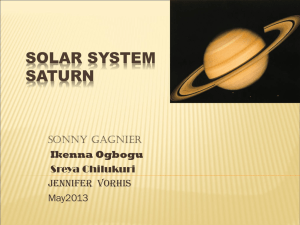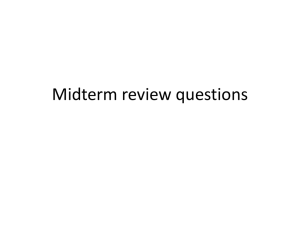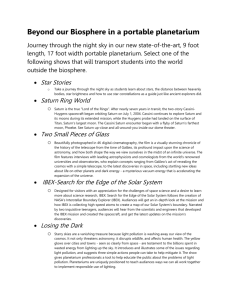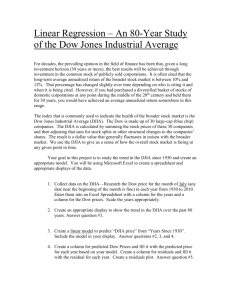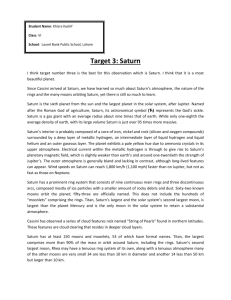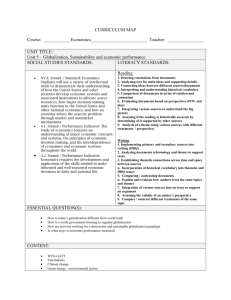Saturn V T 100g in 129 years of DJIA By Hindemburg Melão Jr. www
advertisement
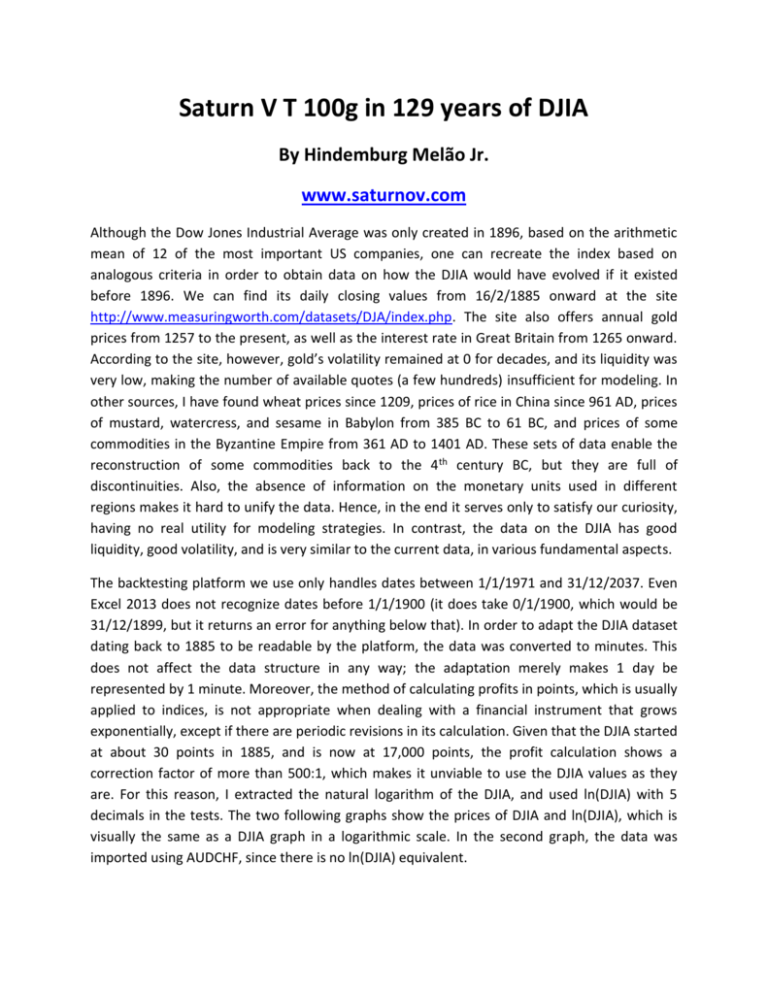
Saturn V T 100g in 129 years of DJIA By Hindemburg Melão Jr. www.saturnov.com Although the Dow Jones Industrial Average was only created in 1896, based on the arithmetic mean of 12 of the most important US companies, one can recreate the index based on analogous criteria in order to obtain data on how the DJIA would have evolved if it existed before 1896. We can find its daily closing values from 16/2/1885 onward at the site http://www.measuringworth.com/datasets/DJA/index.php. The site also offers annual gold prices from 1257 to the present, as well as the interest rate in Great Britain from 1265 onward. According to the site, however, gold’s volatility remained at 0 for decades, and its liquidity was very low, making the number of available quotes (a few hundreds) insufficient for modeling. In other sources, I have found wheat prices since 1209, prices of rice in China since 961 AD, prices of mustard, watercress, and sesame in Babylon from 385 BC to 61 BC, and prices of some commodities in the Byzantine Empire from 361 AD to 1401 AD. These sets of data enable the reconstruction of some commodities back to the 4th century BC, but they are full of discontinuities. Also, the absence of information on the monetary units used in different regions makes it hard to unify the data. Hence, in the end it serves only to satisfy our curiosity, having no real utility for modeling strategies. In contrast, the data on the DJIA has good liquidity, good volatility, and is very similar to the current data, in various fundamental aspects. The backtesting platform we use only handles dates between 1/1/1971 and 31/12/2037. Even Excel 2013 does not recognize dates before 1/1/1900 (it does take 0/1/1900, which would be 31/12/1899, but it returns an error for anything below that). In order to adapt the DJIA dataset dating back to 1885 to be readable by the platform, the data was converted to minutes. This does not affect the data structure in any way; the adaptation merely makes 1 day be represented by 1 minute. Moreover, the method of calculating profits in points, which is usually applied to indices, is not appropriate when dealing with a financial instrument that grows exponentially, except if there are periodic revisions in its calculation. Given that the DJIA started at about 30 points in 1885, and is now at 17,000 points, the profit calculation shows a correction factor of more than 500:1, which makes it unviable to use the DJIA values as they are. For this reason, I extracted the natural logarithm of the DJIA, and used ln(DJIA) with 5 decimals in the tests. The two following graphs show the prices of DJIA and ln(DJIA), which is visually the same as a DJIA graph in a logarithmic scale. In the second graph, the data was imported using AUDCHF, since there is no ln(DJIA) equivalent. In a logarithmic scale, one can better visualize various critical moments of DJIA’s history, like the crisis of 1929, which still remains as the most serious in history. One can also see that the crisis of 2008 was not much worse than the ones that happened in 1907 and 1937. The DJIA data in the website do not include the day’s high, low, or open. They only include the closing value of each day. In order to conduct the backtests, it is necessary to have complete candles, generated through Wiener processes, with 200 internal ticks each, using the each day’s close to determine the following day’s open. This allows us to simulate a situation similar to that which we would have found if we had DJIA prices in intervals of 5 minutes since 1885. In order to verify the quality of this type of candle generation, Saturn V T 100 g0002 was tested in recent DJIA tick-by-tick data from 2013 to 2014, and then on DJIA with 200 artificial ticks per day from 2013 to 2014. The results were very similar, as seen in the table on the right. An 82% similarity in balance is a bit below what we desired, but since we are dealing with a study to validate a historical dataset, instead of with an optimization to select setups to be used in real accounts, it does not constitute a worrisome problem. Besides, to reconstitute intermediate prices using only EOD (End of Day) data and achieve such a good similarity nonetheless is a fairly positive result. If we use the period from 1885 to 1903 for the optimization, and then run the champion genotype over the 100 following years, we obtain a result above our expectations. In a previous article, Saturn 6.1 was tested on 82 years of DJIA. It was optimized between 1928 and 1935, and then tested on the following 75 years. The best setup obtained from the optimization was not able to yield much more than 7.1% per year, on average, which is better than the 4.2% from buying and holding the index, but still far below the performances achieved by Saturn in EURUSD. Also, version 6.1’s worst drawdown was close to 50%, while buy-and-hold’s almost reached 90%. Therefore, Saturn V 6.1 revealed itself to be more profitable, more stable, and less risky than a buy-and-hold strategy on the DJIA. More details about this study can be found at http://www.saturnov.com/artigos/137-algumas-propriedades-do-dji Now the tests with version T 100g have shown much more impressive results. Right in the first optimization (the champion among 10,496 genotypes tested), it already yielded average annual returns of 14.77%, with a maximum drawdown of 44.08%. The practice of buying and holding the DJIA for the same period would have yielded a 4.99% yearly return, suffering a maximum drawdown of 89.36%. The DJIA behaved fairly similarly in this period relative to the period from 1928 to 2010, but Saturn V T 100 revealed itself to be far superior to Saturn V 6.1. Not only does it yield a higher performance than 6.1, but it also does not exhibit one of the problems faced by Saturn V 6.1 in the year of 1966, although it does show a decrease in performance in 1965-1967. The difference is that version 6.1 sunk in 1966 and could no longer trade after that, if it used the setup obtained from the optimization done from 1928 to 1935. It would be easy to solve this by doing a new optimization using data from 1950 to 1966, as described in the article at the time. But Saturn V T 100 does not need this. It adapts to the new scenario without any need for additional intervention, and soon after a brief drop in performance in 1965-1967, it recovers and delivers good results in the following years. In later optimizations, Saturn V T 100g attained even more remarkable performances, with annual returns of 36.64% and a maximum drawdown of only 17.90%. This result was obtained with no leverage (using 1% of the balance in each trade, with 100:1 leverage). It is also interesting to note that in some of the periods when most funds and banks went bankrupt, Saturn V had great success. During the crash of 1929, Saturn had above-average gains, as well as during the Greek crisis in 2010. It went through the crises of 1907, 1937, 1973, 1987-88, 1999-2000, and 2007-2008 with indifference, holding performance approximately equal to any other randomly chosen moment, thus demonstrating great robustness to market turbulences. Actually, it would be expected that Saturn performed better in these periods of long price drops, since it is a trend following setup system. The importance of this study is mainly the confirmation of Saturn V T 100g long-term stability. Using exclusively data from 1885 to 1903, Saturn V can be optimized to generate a genotype capable of delivering profits in the next 100 years, with no need for updates or improvements. This is partly due to the superior adaptability criteria. Saturn V goes through long scenarios of euphoria, long scenarios of crisis, panic, depression, and stagnation, holding performance approximately stable in any of them. The graph below shows one of the studies conducted on the homogeneity of Saturn V trading the DJIA: In order to exacerbate the oscillations and make them more visible, we took on a higher risk level than normal, which resulted in performances close to 119% per year, on average. The graph, in logarithmic scale, shows the evolution curves of a hypothetical portfolio of $100,000 managed by Saturn V from 1885 to 2014, trading the Dow Jones Industrial Average. Performances were segmented in 11 periods of approximately 12 years each (except for the last period, which is 9-years long), in order to compare how Saturn behaves in different time periods. The first period starts in 16/2/1885. We can observe a fairly large similarity between performances in different periods. The x-axis represents the number of trades executed, which has emerged as the variable that is most strongly correlated to performance. That is, for the same number of trades in two different periods, performance is more similar than two distinct periods of the same length. Approximately in the middle of series 4, the NYSE crash occurs, resulting in abnormally high gains for Saturn, for it encounters particularly strong trends. The same occurs in the crisis of 2010, about halfway through series 11, but not so acutely. Abstaining from these two cases, the other series can be stratified in two groups, within each there are very similar components. It is interesting that while the crisis in Greece was a problem Saturn V 4, but it is a gift for versions 6 and newer to reap above-average profits. A cluster analysis points to two main strata and a stratum formed by anomalies. The first stratum goes from 1885 to 1897. It seems that the 12 firms that composed the index started behaving sensibly differently once the index was officially created. The period ranging from 1946 to 1967 is also part of this stratum. The beginning of this period is probably defined by the end of World War II and/or by the Bretton Woods Agreement. In the year of 1967 I do not know which relevant event permanently altered the behavior of the index. The other stratum is comprised of the remaining periods. The exceptions occur from 1929 to 1932, with the crash of the NYSE, and in the beginning of 2010, with the Greek crisis and its effects on the economies of Europe and of the world. Curiously, the subprime crisis, in 20072008, does not affect the general properties of the DJIA as strongly; it only yields a downtrend with normal general properties, similar to those in 1907, 1937, 1987-1988, and 1999-2000. We can observe very strong homogeneity in the general behavior of the portfolio evolution curve in different times, especially when they are part of the same stratum. With such a high level of homogeneity, it becomes possible to make more precise performance forecasts, with less risk of error in the projection. Both cases cited (1929 and 2010), which showed significant anomalies in performance, yielded abnormally high results, but there were two other anomalies that had the opposite effect. The third anomaly is not visible in the graph because it occurs right at the beginning of series 6, around 1946-1947, and it causes a performance drop, pushing the curve to the lower group. There is also another anomaly at the end of series 10, around 2002-2003, that also pushes the series downward. It coincides with the time when the Euro entered into circulation as a physical currency, but I do not know whether this was the determining factor for this effect. Simulations like this are extremely important and precious to validate a strategy for long periods, for it involves a great variety of rare situations, situations that occur once every few decades, and may not be present in the scenarios seen in the past 10, 20, or 30 years, but could occur in a period of 50 or 100 years. The results obtained by Saturn V in 129 years of the DJIA showed unprecedented levels of stability and homogeneity. The maximum amplitude of the variability in Saturn’s results is about half the variability seen in the DJIA, so the level of risk exposure taken by Saturn is less than half than the risk taken by those who bought and held the DJIA in the same period, while Saturn’s annual performance is 7 times greater than that of the DJIA. This represents a risk-reward ratio about 15 times better than a buy-and-hold strategy. But what can we say about backtests with synthetic data on 1,000 years, 100,000 years, and even 1,000,000 years? The answer is: in most cases, they are completely useless. There is an immense difference between interpolating real data to fill candles with artificial ticks, and using a small set of parameters, arbitrarily chosen from the properties of real data, to extrapolate data and create entire series of artificial prices. Filling candles with artificial ticks, if done properly, is a legitimate procedure that can be easily validated. One merely has to choose a period of a few years on which one has real ticks, backtest a strategy, then remove the ticks from these candles, fill them again with artificial ticks, and run the same strategy again. If results are similar, it is an indication that the procedure is valid. When it comes to generating thousands or even millions of years of artificial ticks, unless one conducts a proper test to test the hypothesis that these artificial prices are representative of what would be expected in real scenarios, the series generated will be useless. But this is a topic for another article.
